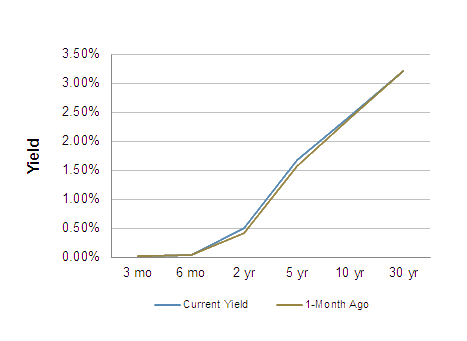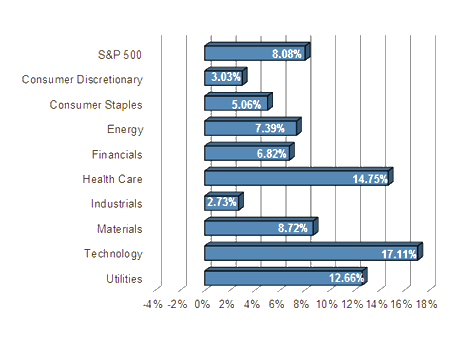 Clarksville, TN – The economic data were mixed. ISM surveys were stronger than expected. Unit auto sales rocketed to a 17.4 million seasonally adjusted annual rate, the strongest pace since January 2006.
Clarksville, TN – The economic data were mixed. ISM surveys were stronger than expected. Unit auto sales rocketed to a 17.4 million seasonally adjusted annual rate, the strongest pace since January 2006.
The Fed’s Beige Book, the summary of anecdotal economic information from the 12 Federal Reserve districts, was essentially more of the same (growth described as “modest to moderate”). The August Employment Report was disappointing.

The unemployment rate edged down to 6.1%, but results varied by age cohort (down for teenagers and young adults, suggesting possible issues with the seasonal adjustment, and slightly higher for prime-aged and older workers). Average hourly earnings rose 2.1% y/y (in comparison, the CPI rose 2.0% over the 12 months ending in July).
The European Central Bank’s Governing Council surprised the financial markets by cutting short-term interest rates. In his press conference, ECB President Mario Draghi announced that a program to purchase asset-backed securities would begin in October.
Draghi said that these securities would be accepted as collateral and would not be purchased outright – hence, technically not “quantitative easing” – but Draghi indicated that the ECB could embark on real QE (that purchases of sovereign debt) if needed. The euro fell on the news.
Next week, the economic calendar thins out considerably (the following week will more than make up for that). The retail sales report is the obvious highlight and should get more attention than usual, following the soft reading in July.
Increased motor vehicle sales should dominate the report, but we should see a strong rebound otherwise (tempered somewhat by lower gasoline prices). Attention should turn ahead to the Fed’s policy meeting, while international investors are likely to eye the vote on Scottish Independence.
Indices
| Last | Last Week | YTD return % | |
| DJIA | 17069.58 | 17079.57 | 2.97% |
| NASDAQ | 4562.29 | 4557.70 | 9.23% |
| S&P 500 | 1997.65 | 1996.74 | 8.08% |
| MSCI EAFE | 1932.53 | 1922.86 | 0.88% |
| Russell 2000 | 1167.21 | 1165.95 | 0.31% |
Consumer Money Rates
| Last | 1-year ago | |
| Prime Rate | 3.25 | 3.25 |
| Fed Funds | 0.09 | 0.03 |
| 30-year mortgage | 4.10 | 4.57 |
Currencies
| Last | 1-year ago | |
| Dollars per British Pound | 1.645 | 1.561 |
| Dollars per Euro | 1.313 | 1.318 |
| Japanese Yen per Dollar | 104.970 | 99.450 |
| Canadian Dollars per Dollar | 1.089 | 1.049 |
| Mexican Peso per Dollar | 13.083 | 13.328 |
Commodities
| Last | 1-year ago | |
| Crude Oil | 94.45 | 107.23 |
| Gold | 1271.32 | 1402.95 |
Bond Rates
| Last | 1-month ago | |
| 2-year treasury | 0.50 | 0.42 |
| 10-year treasury | 2.43 | 2.39 |
| 10-year municipal (TEY) | 3.31 | 3.52 |
Treasury Yield Curve – 9/5/2014
S&P Sector Performance (YTD) – 9/05/2014
Economic Calendar
| September 9th | — | Small Business Optimism Index (August) |
| September 11th | — | Jobless Claims (week ending September 6) |
| September 12th | — | Retail Sales (August) |
| September 17th | — | FOMC Policy Decision, Yellen Press Conference |
| September 18th | — | Scottish Independence Referendum |
| October 3rd | — | Employment Report (September) |
Important Disclosures
US government bonds and treasury bills are guaranteed by the US government and, if held to maturity, offer a fixed rate of return and guaranteed principal value. US government bonds are issued and guaranteed as to the timely payment of principal and interest by the federal government. Treasury bills are certificates reflecting short-term (less than one year) obligations of the US government.
Commodities trading is generally considered speculative because of the significant potential for investment loss. Markets for commodities are likely to be volatile and there may be sharp price fluctuations even during periods when prices overall are rising. Specific sector investing can be subject to different and greater risks than more diversified investments.
Tax Equiv Muni yields (TEY) assume a 35% tax rate on triple-A rated, tax-exempt insured revenue bonds.
![]() Material prepared by Raymond James for use by its financial advisors.
Material prepared by Raymond James for use by its financial advisors.
The information contained herein has been obtained from sources considered reliable, but we do not guarantee that the foregoing material is accurate or complete. Data source: Bloomberg, as of close of business September 3rd, 2014.
©2014 Raymond James Financial Services, Inc. member FINRA / SIPC.




